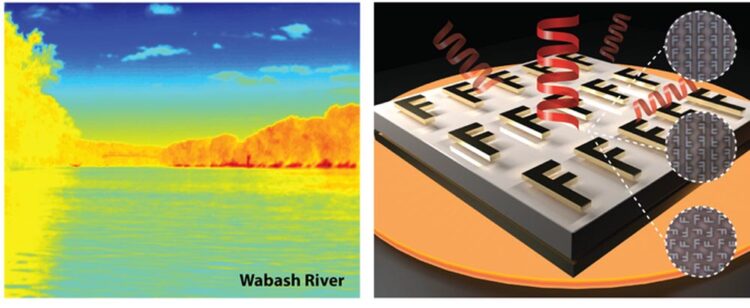Researchers uncover a new method for generating spinning thermal radiation

Thermal Image of Wabash River (left), near Purdue University's campus. Most conventional objects show weak to zero circular polarization in the emitted heat signal. By using metasurfaces (right) made up of arrays of F-shaped nanostructures with various symmetries, researchers are able to generate circular polarized thermal radiation in a controlled and efficient manner.
Credit: Purdue University image/Xueji Wang
Researchers at Purdue University have made a groundbreaking discovery in the field of thermal radiation, uncovering a new method for generating spinning thermal radiation in a controlled and efficient manner using artificially structured surfaces, known as metasurfaces.
The team, led by Zubin Jacob, Purdue’s Elmore Associate Professor of Electrical and Computer Engineering, has published findings in the journal Science Advances, titled “Observation of non-vanishing optical helicity in thermal radiation from symmetry-broken metasurfaces.”
Thermal radiation, which originates from random fluctuations in materials, is traditionally considered an incoherent signal. Most conventional thermal emitters show weak to zero circular polarization in the emitted heat. Surprisingly, the thermal radiation reaching the earth from many astronomical objects possesses significant circular polarization. This intriguing phenomenon leads to the discovery of strong magnetic fields in some condensed stars, offers explanations of puzzles about the early universe, and even provides a possible signature of life.
“Spinning thermal radiation is extremely rare in nature and is only found in some condensed stars,” Jacob said. “Our work provides a new way to generate this type of radiation, which has the potential to be used in a variety of applications, including thermal imaging and communication.”
The researchers discovered that by using a metasurface made up of an array of F-shaped structures, they were able to generate predominantly left-handed circularly polarized thermal radiation in all directions, resulting in non-vanishing optical helicity for the first time. The team reached 39% of the fundamental limit in optical helicity with their design, and they also showed that the characteristics of emitted thermal photons can be tailored by the symmetries of the metasurface, demonstrating effective control over thermal radiation in its various properties.
“This research could have important implications for understanding the omnipresent thermal radiation phenomenon and for developing new technologies,” Jacob said. Potential applications include using the metasurface as a wide-angle, narrow-band circular-polarized mid-infrared light source for optical gas sensing and infrared imaging. Additionally, the unique spectral, spatial, and spin feature of the engineered thermal emission can be exploited as passive infrared beacons in outdoor environments, making them useful in remote sensing technology.
“We are extremely excited about the potential of this discovery,” says PhD student Xueji Wang. “Not only does it deepen our understanding of thermal radiation, but it also opens up new possibilities for technological advancements in a variety of fields.”
The research was funded by the DARPA Nascent Light Matter Interaction (NLM) program.
Journal: Science Advances
DOI: 10.1126/sciadv.ade4203
Article Title: Observation of nonvanishing optical helicity in thermal radiation from symmetry-broken metasurfaces
Article Publication Date: 27-Jan-2023
Media Contact
Kayla Wiles
Purdue University
wiles5@purdue.edu
Office: 765-494-2432 x2432
All latest news from the category: Power and Electrical Engineering
This topic covers issues related to energy generation, conversion, transportation and consumption and how the industry is addressing the challenge of energy efficiency in general.
innovations-report provides in-depth and informative reports and articles on subjects ranging from wind energy, fuel cell technology, solar energy, geothermal energy, petroleum, gas, nuclear engineering, alternative energy and energy efficiency to fusion, hydrogen and superconductor technologies.
Newest articles

Largest magnetic anisotropy of a molecule measured at BESSY II
At the Berlin synchrotron radiation source BESSY II, the largest magnetic anisotropy of a single molecule ever measured experimentally has been determined. The larger this anisotropy is, the better a…

Breaking boundaries: Researchers isolate quantum coherence in classical light systems
LSU quantum researchers uncover hidden quantum behaviors within classical light, which could make quantum technologies robust. Understanding the boundary between classical and quantum physics has long been a central question…

MRI-first strategy for prostate cancer detection proves to be safe
Active monitoring is a sufficiently safe option when prostate MRI findings are negative. There are several strategies for the early detection of prostate cancer. The first step is often a…



